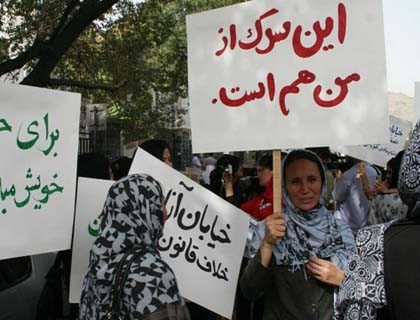Last week, a group of young Afghan women held a peaceful demonstration in Kabul against increasing street harassment in the country. They were carrying placards and handing out leaflets, which were written about verbal and physical abuses enduring Afghan women on daily basis. I really do not know much about this particular issue in modern history of Afghanistan. But, according to documents and videos which are available from 70s and 80s, street harassment in Kabul city—perhaps, in major parts of the country, women had no large presence in social, economic or political issues to spark a reaction in male-dominated society - was not in extent to cause women to stop working out or getting education.
Now the situation has turned grim. Let me explain this phenomenon with simple examples. During 2006-7, I was teaching in some English language education centers in Kabul. According to program, one day, I divided students into two separate groups and wrote a topic for a class discussion. In order to motivate them to speak, the topic was a bit sensitive and linked to status of woman in Afghan society. From the very start, many female students started complaining about increasing street harassment and street abuse in Kabul. One of them turned and frankly said, "Sir, you do not understand what we are talking, because you are not a girl to endure physical and verbal abuses as we do on daily basis". "Even old men, riding on bicycle, looking hungry and starved, when passes from a girl or a group of school age girls, they mostly use abusive words".
However, it may look like exaggeration but it is the reality of Afghan society. There are various types of street harassment, like staring, stalking, teasing, touching, shouldering, driving cars directly towards them, horning when crossing women, and, finally, verbal abuses. These all have become prevalent in the Kabul city. In rush places, crooks mostly try to take advantage and touch women bodies while crossing them. In the rush markets, mostly such incidents take place. Same is the case when people prepare for particular events, like Eid days and etc. Similarly, when a woman walk alone across roads, without male partners, motorbikes and cars stop and start horning and asking her to get inside.
If any women go alone out, it is really hard to come back and has not been abused physically or verbally.
A mere observance of Afghan women presence in so-called open cities like Kabul, we can easily understand the sufferings they endure on daily basis. In a normal day, the percentage of Afghan women in public places, like parks, markets, restaurants, hotels and streets is bellow 30, in comparison to male presence. But even this share of women in the society does not remain fixed during an entire day. Just after 5 p.m., they start rushing back to their houses; many of them do so to avoid harassment. After six o'clock in afternoon, the percentage between male and female in Kabul shopping malls and streets hardly stand at five. When it gets dark, while we have huge presence of men everywhere, there are no women at all.
Perhaps, many do not like my standards, because I have not assessed the status of women on the basis of formal standards, like approved laws, establishment of separate ministries, their participation in political parties, percentage in schools and etc. I think some of these conventional standards are perverting and make to ignore ground realities. According to some of the standards, we have had grand achievements during past ten years of international community's engagement. Presently, we have around 69 female MPs in Parliament, a separate ministry for women, visible number in Media and Press and etc. in another word; we have a modern constitution that includes valuable rights for Afghan women that can not be violated easily if Afghan government remains committed to enforce them. What has turned to be a challenge ahead of empowerment of women and improvement of their status in all spheres is the tradition and society.
As I noticed previously, street harassment was not that prevalent in former decades. But after the outstation of Dr Najib government in Kabul, and subsequent start of destructive civil war mostly pushed women into margins. While in the forefront of violence and bloodshed were men, and women hardly took part in battlefields. That period of civil war has lasted more than two decades and during these two decades, the role of women was undermined and diminished to minor issues. It was time for those who had strong muscle that can wield arms and survive longer in battlefields.
Therefore, since women were not as good as their male partners in shooting, firings and of course brutality and violence, they naturally were pushed into back stage. This process was further accelerated as Taliban regime took power and established a sharia-oriented government. Under that regime, women were disowned from all their rights and degraded into second-rate citizen. Therefore, during those more than two decades, a new concept was formed and grew towards women, which cannot be eliminated without comprehensive efforts.
I think what we are observing and what women endure nowadays is the reactionary move of society against a new process, which is supported by international community and aims to revive the status of women as first class citizen.
This reactionary, at best scenario, is dealing with suffering to tens of thousands of women and, at worst scenario, can restrict their presence in social, political and economic spheres. And the law remains weak to solve the problem, even if government becomes enough strong to enforce each and every article of approved laws of the country. There is need of cultural reforms through raising the percentage of literacy and etc.

